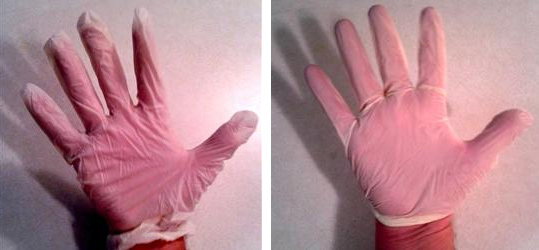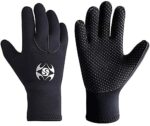People usually talk about the types or the quality of gloves that one should wear to work. However, one very important aspect that gets overshadowed is what’s the correct size for disposable gloves. The idea should be to wear a snug-fitting glove that’s neither too tight nor loose.
Determining the right size will also depend upon the work you do and the type of glove you’re wearing. Disposable gloves can be either nitrile, vinyl, latex, or synthetic. Each of the types is used in different industries.
Sometimes, you will require protection from liquids and organic acids, at times, it would be thorns and soil, and some other times, it could be protection from viruses, blood-borne pathogens, toxins, and things that are much more harmful.
Come what may, the job of a disposable glove you’re wearing is to protect your hands from hazards. Sadly, if the glove doesn’t fit (too tight or too loose), it will be as good as nothing. Hence, the size and fit of the gloves should be taken very seriously.

It might sound very simple – just put on the glove and you’ll know, they say – but it isn’t. Remember, a loose-fitting glove is the biggest mistake one can make while working at a lab, in an OT or examination room, in a dental office, and even while doing something as simple as gardening.
It’s close-fitting disposable gloves that offer protection – but the question is, how do you find out if your gloves are close-fitting or loose-fitting. Other than the scenario that your gloves are twice the size of your hand, you cannot simply have a glance and tell which from which (loose-fitting from close-fitting).
Walk through this guide to find out how tight or loose your disposable gloves should be, how do you measure a hand for disposable gloves, what’s the fine line between close-fitting (snug) and tight, and much more.
How Tight Should Disposable Gloves be: Close-fitting or Loose-Fitting?
One of the biggest reasons that most people end up with the wrong size of glove that’s too tight or loose is they do not understand the difference between too tight, loose, and close-fitting.
1.) Too tight will restrict your motion.
2.) Loose will pose the threat that liquids will seep inside the gloves while you are wearing them.
3.) Close-fitting (snug-fitting) will offer the protection that disposable gloves should ideally offer.
The fact that’s established up until now is that disposable gloves should be close-fitting. That’s the only way you won’t lose dexterity while working and your hands will not lose grip of whatever you’re holding or handling.
How Do You Know If a Glove Fits?
A glove should fit like a dream as if it’s your second skin – they say. But how do you know it? Is it just comfort or some other technicalities are involved that can help you take a call if the gloves are close-fitting or loose-fitting?
If these questions have been holding you back from buying the right gloves, then the answer is that comfort alone cannot differentiate between close-fitting and loose-fitting. You have to understand that loose-fitting is a lot more complicated and diverse than you think.
The closest form of loose-fitting that can be clearly seen is when the glove keeps bunching around your wrists or there’s a lot of space left between the fingers and the surface of the gloves – that much is obvious that these gloves are loose.
But, gloves that might look ok around your wrists and fit the length of your fingers could still be loose. What about those gloves? It is here that you need to keep an eye on the factors listed below. Only then you’ll be able to differentiate between close-fitting and marginal loose fitting.
See also: How Do You Make Disposable Gloves Tighter?
1.) You have to look at the width of the fingers alongside the length – The gloves could be comfortable as long as the fingers fit inside them lengthwise. But if the same gloves are loose width-wise, the fingers will still keep slipping. You won’t get the much-needed grip.
2.) You have to look at the folds on the palm – It might look like the gloves are hugging your palms from the top very comfortably, but if there are many folds created on the palms, the gloves are a little too loose for comfort.
3.) You have to Consider the Stretch – Stretch your palms as best as you can and as far as the fingers go. If your fingers still do not touch the tip of the gloves despite you’re stretching a little beyond what’s comfortable, the gloves are again loose.
All these 3 factors are very important when you’re trying to know if the gloves you’re wearing are snug or loose. A close-fitting glove offers a snug-fitting.
Here’s what a close-fitting glove feels like:
1.) A close-fitting glove fits the width of the fingers along the length of the fingers.
2.) A close-fitting glove when stretched beyond what’s comfortable (or required), will touch the tip of the gloves (at least, the middle finger will).
3.) A close-fitting glove will have very few folds on the palm. Too many folds mean the gloves are loose and no fold means that the gloves are too tight.
Dangers of Wearing Disposable gloves that are the Wrong Size
As we already mentioned, the wrong fitting includes both loose-fitting and tight-fitting. It always has to be a truce between the two. In both cases, wearing loose-fitting gloves or tight-fitting gloves, your hands are at risk. Find out how in the upcoming sections.
What will happen when surgical gloves are too tight?
Surgical gloves can be used across all industries. When they’re too tight, you will face the following problems:
1.) Your motion will be constricted. Your fingers will not have the freedom to stretch comfortably. It will affect your efficiency.
2.) Your hands get quickly tired and fatigued inside tight gloves. The minute you stretch your fingers fully and hold the stretch for comfort, the gloves might rip off.
3.) Blood flow will reduce when the gloves are too tight. Your fingers will be numb and cold. You’ll lose the grip of the instruments (surgical tools if you’re a doctor or items like a tray or sack of food bag if you’re working in the food processing industry) you’re holding or handling.
4.) Your hands will hurt at the end of the day (every day) until you stop putting on the gloves entirely.
What will happen if the gloves are loose?
Loose gloves have constraints of their own. Let’s find out the most significant ones:
1.) Your fingers will keep slipping inside the gloves. You won’t be able to grip whatever you’re holding.
2.) It will hamper work efficiency.
3.) You’ll be exposed to liquids, acids, and contaminants you’re trying to protect your hands from.
In both cases – too tight and too loose – you’re at risk and your work efficiency is getting tossed out of the window.
How Do You Measure A Hand For Disposable Gloves?
By now you know the difference between all types of fittings and the risks involved! So, let’s now help you understand how you should measure your hand so that you can find a close-fitting glove that will be your perfect fit.
1.) Take an inch-tape.
2.) Wrap it around the widest part of your palm to find out the circumference in inches. The widest part of the palm should be measured excluding the thumb. Note down the number.
3.) Now, stretch your fingers to their maximum length. Keep one end of the measuring tape on the tip of your middle finger while your fingers are fully stretched.
Trace the length of the palms starting from the tip of the middle finger up until the base of the hand in a straight line.
You have the width and the length in inches in front of you now. Round off the larger of the two and that’s your close-fitting glove size.
Let’s give you an example: if the length of the palm was 6.6 inches and the circumference was 5.8 inches, it’s 6.6 that you should consider. When rounded off, 6.6 becomes 7. So, in this case, your glove size is 7.

Here’s a general standard glove size chart that most major brands follow:
Glove sizes for men:
-
-
- Extra Small: Equal to or less than 7½”.
- Small: between 7½” to 8½”.
- Medium: between 8½” to 9½”.
- Large: between 9½” to 10½”.
- Extra Large: between 10½” to 11½”.
- XXL: Equal to or larger than 11½”.
-
Glove sizes for women:
-
-
- Extra Small: equal to or smaller than 6½”.
- Small: between 6½” to 7”.
- Medium: between 7” to 7½”.
- Large: between 7½” to 8”.
- Extra Large: equal to or larger than 8”.
-
Note: these are the sizes that most brands use. But always check the size chart provided by the manufacturers because some brands might run a size smaller or larger. Just to be on the safer side of the water, always read the size chart!
5 Things You Should Remember About Adjusting The Fit of Your Disposable Gloves – The Do’s and Don’ts
1.) It’s always a wise choice to buy ambidextrous gloves since finding the right size is easier no matter if you’re a left-handed person or a right-handed person. In case the gloves you’re buying are not ambidextrous, take the measurement of your working hand.
2.) There are different types of disposable gloves available. If you’re allergic to a particular material, wear something you’re not allergic to.
3.) Do not touch your face after you’ve started working with your gloves on.
4.) Do not reuse the same gloves even if they look perfectly fine at the end of the day. They’re made disposable for a reason. Always start your day with a fresh pair of gloves.
5.) Check the expiry date of the batch. Yes, you heard us just fine: every batch of disposable gloves has an expiry date. Make sure that you do not wear gloves from an expired batch. It will put you and others at risk.
Concluding Thoughts:
Close-fitting gloves are always the right choice. Loose-fitting gloves or tight gloves are uncomfortable, they reduce your ability to perform the task at hand, and they loosen your grip on the objects you’re working with. Also, always follow the size guidelines so that you find the perfect snug-fitting glove.
Do not solely rely on how comfy your hands feel inside the gloves – the gloves could still be loose. Consider all the factors we have mentioned so that the gloves you finally buy protect you, not endanger you!







